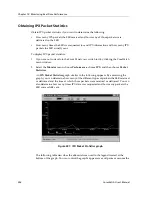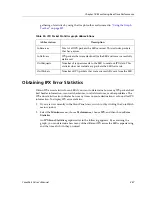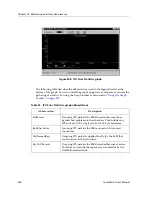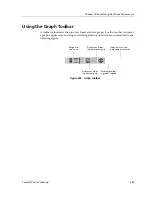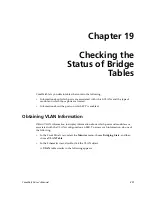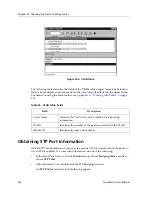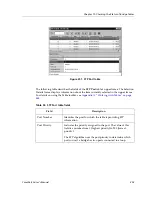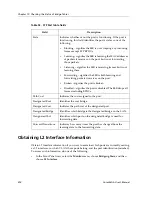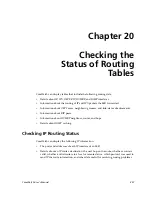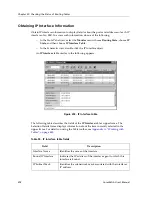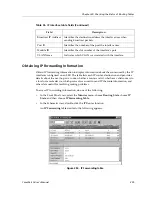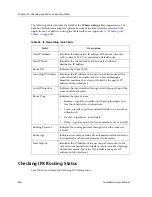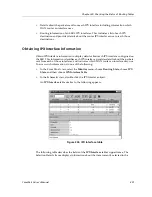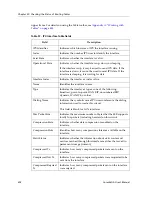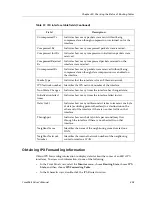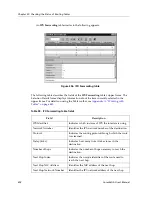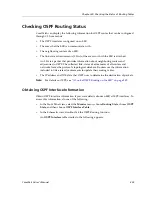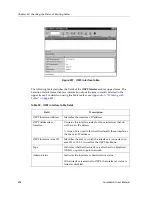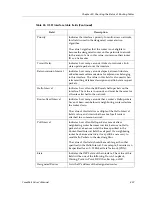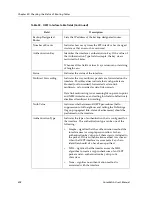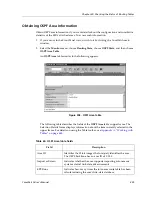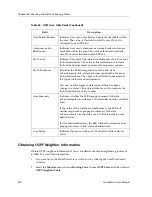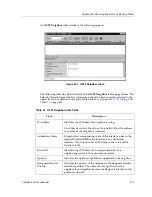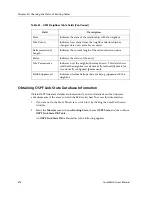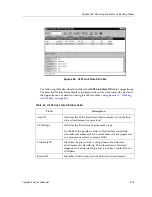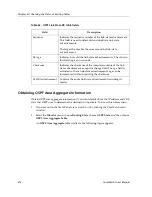
Chapter 20: Checking the Status of Routing Tables
400
CoreWatch User’s Manual
The following table describes the fields of the
IP Forwarding
table's upper frame. The
Selection Details frame displays information about the item currently selected in the
upper frame. For details on using the Table toolbar, see
Appendix A:
“Working with
Tables” on page 443
.
Checking IPX Routing Status
CoreWatch can display the following IPX information:
Table 56. IP Forwarding table fields
Field
Description
Dest IP Address
Identifies the destination IP address of the route. An entry
with a value of 0.0.0.0 is considered a default route.
Dest IP Mask
Identifies the subnetwork mask associated with the
destination IP address.
Route TOS
Indicates the route's TOS.
Next Hop IP Address
Identifies the IP address of the next hop of this route. (If the
route is bound to an interface that is accessed through a
broadcast medium, the value of this field is the agent's IP
address on that interface.)
Local IP Interface
Indicates the local interface through which the next hop of the
route should be reached.
Route Type
Indicates the type of route.
•
Remote—signifies an indirect path going through a non-
local host, network, or subnetwork.
•
Local—signifies a path connected directly to a network or
subnetwork.
•
Invalid—signifies an invalid path.
•
Other—signifies a path that is not remote, local, or invalid.
Routing Protocol
Indicates the routing protocol through which the route was
learned.
Route Age
Indicates how many seconds have elapsed since this route was
last updated or otherwise determined to be correct.
Next Hop AS
Identifies the IP address of the next hop of this route. (In the
case of a route bound to an interface which is realized through
a broadcast media, the value of this field is the agent's IP
address on that interface.)
Summary of Contents for CoreWatch
Page 1: ...CoreWatch User s Manual 9032564 04...
Page 2: ...Notice 2 CoreWatch User s Manual...
Page 20: ...Preface 20 CoreWatch User s Manual...
Page 64: ...Chapter 5 Changing System Settings 64 CoreWatch User s Manual...
Page 86: ...Chapter 6 Configuring SSR Bridging 86 CoreWatch User s Manual...
Page 106: ...Chapter 7 Configuring VLANs on the SSR 106 CoreWatch User s Manual...
Page 206: ...Chapter 12 Configuring QoS on the SSR 206 CoreWatch User s Manual...
Page 246: ...Chapter 13 Configuring Security on the SSR 246 CoreWatch User s Manual...
Page 363: ...CoreWatch User s Manual 363 Chapter 16 Configuring Routing Policies on the SSR 9 Click OK...
Page 364: ...Chapter 16 Configuring Routing Policies on the SSR 364 CoreWatch User s Manual...
Page 370: ...Chapter 17 Checking System Status 370 CoreWatch User s Manual...
Page 390: ...Chapter 18 Monitoring Real Time Performance 390 CoreWatch User s Manual...
Page 396: ...Chapter 19 Checking the Status of Bridge Tables 396 CoreWatch User s Manual...
Page 430: ...Chapter 20 Checking the Status of Routing Tables 430 CoreWatch User s Manual...
Page 442: ...Chapter 22 Obtaining Reports 442 CoreWatch User s Manual...
Page 456: ...Appendix B CoreWatch Menus 456 CoreWatch User s Manual...

